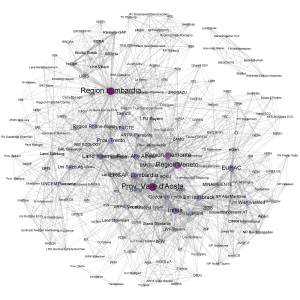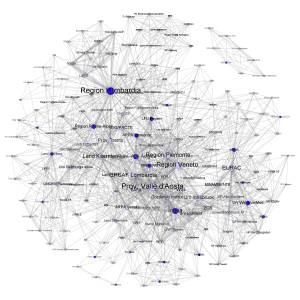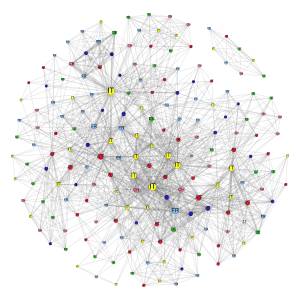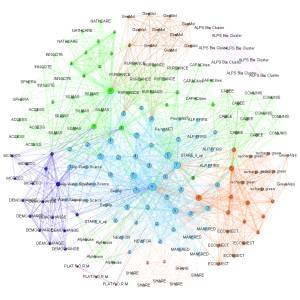Table of Contents
Stakeholder network analysis
Data on project participation of the stakeholders has also been used to analyse the stakeholder network behind the AS projects. For this, we have used social network graphs. These graphs are visual tools that enable us to explore proximity, relationships and their strengths between stakeholders, here the Alpine Space project partners. They have their foundation in social network analysis (see Hanneman and Riddle (2005) for an introduction) which is based on mathematical tools and graph theory. By definition, a social network is simply a set of actors (nodes), that may have relationships (edges) with one another. In our case, the network nodes are all identified stake holding institutions in the 30 AS projects along the 2007-2013 programming period. The list of stakeholders was created using the excel sheet from the JTS. However, this list might be subject to bias as different practices exist in declaring project partners, especially for large institutions such as regions, provinces, universities or research centres (head institution, sub-units). Therefore, and contrary to the main stakeholder analysis, we derived a second dataset by aggregating stakeholders according to their head institutions. In the aggregated dataset, the number of stakeholders dropped from 231 to 189, i.e. 40 institutions are in fact sub-units of head institutions. This generalization gives us insights on the real importance of these head institutions; information that is not available in the disaggregated data. This consideration has consequences for the network graph. The edges are based on the collaborations with other stakeholders that took place during the projects. We do not consider variations in collaboration intensity (e.g. different intensities of collaboration in general, timely variation) as we did not have available such qualitative data. Although data might not appear rich on first sight (lack of intensity), the resulting graphs provide us with valuable insights on the (partial, only 28 projects) network established in the framework of the AS programme.
Method & Software
We used freely available software tools: First, the R statistical software (R Development Core Team, 2008) is used to prepare data on edges and nodes. In a second step, we used gephi network analysis software (Bastian, Heymann, & Jacomy, 2009) to develop the graphs. Network graphs are typically drawn using layout algorithms, which calculate and draw the network based on the data on nodes and edges provided. Here, we used the Fruchterman and Reingold layout algorithm (Fruchterman & Reingold, 1991) that puts emphasis on complementarities between nodes. Once the network is drawn, it reflects centrality of stakeholders in the whole network (position), proximity between stakeholders (more distant stakeholders are less linked) and strength of relationships (number of collaborations, several possible, via thickness of edges). Furthermore, statistical tools and clustering algorithms can be used to explore the stakeholder landscape, e.g. regarding
- local connectivity of stakeholders (termed degree or weighted degree centrality),
- geographic centrality of stakeholders (termed closeness centrality),
- transit centrality of stakeholders (nodes where a lot of transit can happen, termed betweeness centrality),
- authority (termed eigenvector centrality, nodes connected to central nodes are central themselves),
- and clusters of stakeholders, i.e. detection of underlying sub-groups/communities of stakeholders (Levallois, 2014).
For the analysis, we used the following graphs: First, we describe the graph drawn with the aggregated (head institutions) data. We also highlight local connectivity of stakeholders. We then continue exploring in more detail the graph of head institutions, highlighting the distribution of projects, stakeholder role (lead partner, project partner) and countries across the network, and presenting a clustering approach.
Results
The graph shows the social network as established between project partners due to the collaboration in 28 projects across two thematic fields. Figure 1 is based on the aggregated data on institutions, resulting in 189 stakeholders and 1678 edges (links established by project participations). The graph shows the links between stakeholders (thicker edges for more links), their positions in the overall network (proximity to other stakeholders) and their centrality, or function as a hub, expressed here by node and label size and a colour gradation (darker for more central). The centrality measure here is weighted degree, a measure for local connectivity. It is calculated as the sum of edges for a node, weighted by the weight of each edge.
The graph shows that almost all stakeholders of the two thematic fields are interlinked via their collaboration in one or more projects. Different central actors function as hubs, having participated in several projects and tying the network together, especially the Province of Aosta, Region Lombardia and EURAC leap the eye. One project (ALPS-Bio-Cluster) and its stakeholders, however, are not linked to the rest of the network (top-right). Globally, stakeholders situated on the periphery of the resulting circle have less relationships within this network than stakeholders that are situated closer to the centre. We observe a major central network around the Province of Aosta valley, with several central actors in its surrounding like Piemont Region, Veneto Region, ERSAF Lombardia, Land Kärnten and other authorities and research institutions. The research centres EURAC and Irstea are also important hubs but are farer away from the central network, thereby linking further stakeholders to it. Besides the Province of Aosta, a second major player is Region Lombardia, that has many links to stakeholders on the periphery, but it is less connected to the central network. Overall, the central network with its hubs is able to link all project partners (via links of second, third and fourth degree), and is mainly composed by regional or provincial authorities, universities and research centres. This reflects also the fact discovered above that these institutions account for the majority of stakeholders in AS projects.
Further explorations
Further explorations (see Figure 2 and 3) of the stakeholder network highlight that major hubs, such as Province of Aosta valley, ERSAF Lombardia, Land Kärnten and EURAC, do not necessarily to be lead partners (in dark blue on the left graph) in order to become central players in the network. However, some central players such as Region Lombardia and Irstea were lead partners in the projects. Plotting the country of stakeholders as labels (right graph), we see that Italian (yellow), but also Austrian (red) and French stakeholders (light blue) are the most central ones in the network. For Germany (green), Switzerland (pink) and Slovenia (dark blue), only one (LFU Bayern), two (WSL, BAFU) and one (Gozdarski institut) stakeholders are close to the central nodes, respectively. The stakeholders with the most participations and thus multiple links, therefore the most central, are Italian.
Finally, figure 4 shows the same network graph, but with node labels showing project affiliation for stakeholders with only one project and number of projects for stakeholders that participated in more than one project. In addition, node colours reflect the affiliation to clusters. These clusters have been calculated using the Chinese Whispers algorithm, a very basic algorithm that aims at “finding groups of nodes that broadcast the same message to their neighbours” (Biemann, 2006). With regard to the projects, we see that the social network graph positions stakeholders based on the links established by the thematically-related projects. For instance, partners in the project groups ACCESS, MORECO, demochange (territorial and demographic development), RURBANCE, CAPACITIES, COMUNIS (territorial and economic development), INNOCITE, SPHERA, ACCESS, NATHCARE (economic development) and MANFRED, ECONNECT, rechargegreen (environment) are situated close to each other.
The partition of nodes using the clustering approach pushes this idea of grouping even further. It identifies nine clusters in our network, which correspond to the project affiliation of stakeholders and also to the degree of implication. There is a large central cluster (light blue) that collects all stakeholders that make up the “core” of the stakeholder network. It includes the partners that participated often in AS projects, and their competences might touch various subjects (links to the peripheral actors and their projects. Other clusters confirm the grouping according to project themes in this graph. The red cluster highlights stakeholders working on environmental topics, the light green cluster those working on economic and territorial development topics; dark green is on construction, dark red is on geology, and dark blue also refers to territorial development.
Interpretation
In a nutshell, the stakeholder network analysis has provided some additional information on the relationships between stakeholders, which have been established throughout the 30 analysed AS projects. A central network of stakeholders has emerged whose members frequently participate in projects, thereby drawing other, more peripheral stakeholders into the network. Their collaboration (proximity) seems not be constrained by specific thematic focuses, but is probably based on a general interest in the Alpine Space programme (and funding) and in topics related to the Alps. These are the “hot hubs” of the programme. This group is completed by the lead partners, which can but may not be that central. We saw also that a distinction between stakeholders on sub-unit and main unit level does not result in the same network. In this regard, it seems essential to know how strong sub-units of institutions, participating in different projects, exchange information (administrative, project management, or thematic) and can be seen as stakeholders on their own. Information flow between sub-units might vary according to stakeholder types (authority, research centre, university). Finally, the cluster approach has pointed at the presence of some thematic sub-networks, for instance environmental or territorial development issues. Partners, once involved in a project, might explore new pathways and prepare follow-up projects on similar topics, thereby strengthening their links over time and overcoming limits of project duration. In this regard, the Alpine Space programme creates added value through networking.
Sources
- Hanneman, Robert A. and Mark Riddle. 2005. Introduction to social network methods. Riverside, CA: University of California, Riverside (published in digital form).
- R Development Core Team (2008). R: A language and environment for statistical computing. R Foundation for Statistical Computing, Vienna, Austria.
- Bastian, M., Heymann, S., & Jacomy, M. (2009). Gephi: an open source software for exploring and manipulating networks. International AAAI Conference on Weblogs and Social Media.
- Fruchterman, T. M. J., & Reingold, E. M. (1991). Graph drawing by Force-Directed Placement. Software: Practice and Experience, 21(11).
- Levallois, C. (2014): Gephi - Advanced functions. Filters, metrics, plugins and workspaces. Gephi Support Team, Lyon Business School.
- Biemann, C. (2006): Chinese Whispers - an Efficient Graph Clustering Algorithm and its Application to Natural Language Processing Problems. Proceedings of the HLT-NAACL-06 Workshop on Textgraphs-06, New York, USA.
Dominik Cremer-Schulte, Irstea Grenoble, December 2014



